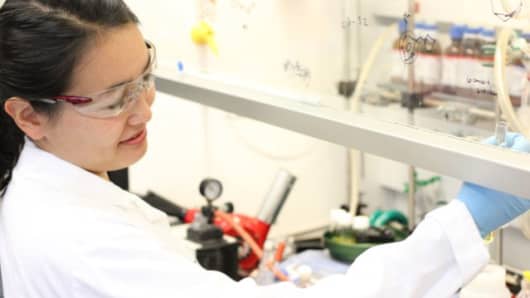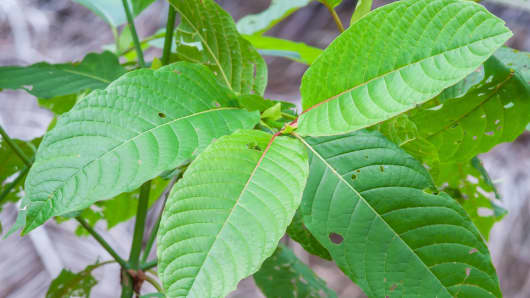http://nbr.com/2016/10/12/new-opioids-could-relieve-pain-without-dangerous-side-effects/
New opioids could relieve pain without dangerous side effects
Once hailed as saviors of pain patients everywhere, opioids — including oxycodone and fentanyl — have caused an addiction epidemic in the United States and earned the scorn of doctors, patients and lawmakers. Some scientists think it’s time to give opioids a second chance, by developing a new generation of drugs with all the painkilling power of conventional opioids but without some of the dangerous side effects.
Researchers are working with three compounds that appear to be the most promising when it comes to reversing the recent rise in opioid addiction and overdose death.
Pennsylvania-based pharmaceutical company Trevena‘s oliceridine has been given preferential regulatory treatment by the FDA; mitragynine pseudoindoxyl, a compound derived from leaves of the Southeast Asian kratom plant, has shown less incidence of addiction in mice trials; and early testing of compound PZM21 has produced results researchers claim are unlike anything they’ve seen from potential painkiller compounds.
The new molecular approach to painkilling
Each of these compounds binds to opioid receptors — specific proteins found in the brain, spinal cord and other organs in the body — just like morphine. But they activate a different signaling pathway, a route through which information flows from one molecule to another, than conventional opioids.
These distinctions mean the new opioids could decrease the risk of addiction and eliminate a leading cause of overdose death: respiratory depression. The fatal side effect drew attention recently after it was deemed the cause of death for popular pop artist Prince.
Brian Shoichet, professor of pharmaceutical chemistry at University of California, San Francisco, and co-author of a paper on PZM21 published last month in Nature, says eliminating this side effect is one of the most important goals in creating new opioids.
“The whole field is sort of opening up, and there’s hope that there’s molecules that at least don’t cause respiratory depression,” he said. “That’s what kills people on opioids.”
Deaths from prescription opioids have quadrupled since 1999, killing more than 28,000 people in 2014, according to the most recent data from the Center for Disease Control and Prevention.
The economic costs are high, too. Prescription opioid overdose, abuse and dependence carries an estimated economic burden of $78.5 billion per year, according to a study published in the October issue of Medical Care.
The statistics — along with the many heartbreaking stories — have prompted politicians to advocate for stricter controls on prescription medications, and doctors — including Surgeon General Vivek Murthy — to advocate for more physician education.
“The whole field is sort of opening up, and there’s hope that there’s molecules that at least don’t cause respiratory depression. That’s what kills people on opioids.”
The DEA announced in October that it is cutting the production quota for opioids like oxycodone, hydrocodone, fentanyl and morphine by at least 25 percent in an attempt to curb the epidemic.
Pharmaceutical companies, like Purdue Pharma — manufacturer of OxyContin — have already made billions off the opioid market. A Los Angeles Times investigation revealed Purdue Pharma has reaped about $31 billion in revenue from OxyContin sales, in part due to aggressive marketing that made the drug seem far less risky than it was.
In 2007, Purdue paid $635 million in fines after pleading guilty to false marketing charges brought by the Department of Justice, and it paid another $24 million to the state of Kentucky in 2015, though it admitted no wrongdoing in that case.
Purdue reformulated OxyContin in 2010, making it more difficult to crush or dissolve the pill in order to snort or inject it. The branded drug represents a small share — less than 5 percent — of all opioid prescriptions, a company representative told CNBC.
In recent years Purdue has also announced several drug development efforts focusing on non-opioid painkillers. Many pharmaceutical companies have also released drugs to treat opioid side effects rather than eliminating them.
Opioid-induced constipation gained national attention after a Super Bowl commercial highlighted the condition earlier this year. Experts say companies like AstraZeneca, which sells a drug to alleviate the condition, can expect to reap large profits, as the market for such drugs is expected to grow to $563 million in annual sales by 2019.
Braeburn Pharmaceuticals announced in May that the first-ever implant used to treat opioid addiction will be priced at $4,950 for a six-month course of treatment.
Researchers are hoping new work in the field of opioid development can solve the problems caused by traditional opioids rather than treating the side effects and repair the reputation of opioids.
“I hope we can recognize this is a new way to approach treating this receptor,” said Laura Bohn, a professor at Scripps Research Institute, who has studied opioid receptors for more than a decade. “And it comes at a time when the receptors are becoming very demonized in the media and politically.”
More from Modern Medicine:
Billions at stake as Bristol-Myers waits its chance to redeem its lung cancer drug
Antibiotics are becoming the David to the Goliath of ‘Superbug’ infections
Writing a prescription … for a dose of electricity
Oliceridine: A breakthrough therapy for hospital patients
Oliceridine, a new intravenous opioid, is in the final stages of human trials conducted by Trevena.
Studies have shown oliceridine relieves pain like morphine but doesn’t cause respiratory depression or constipation, and patients are less likely to build up a tolerance to it.
“Conventional opioid drugs are probably the best analgesics we have, but they have these really serious problems,” said Trevena CEO Maxine Gowen. “For too long I think we have been satisfied with them, but I hope compounds like oliceridine provide a much better option.”
In February the FDA gave oliceridine breakthrough therapy designation, which is granted to new therapies intended to treat serious conditions or drugs that demonstrate substantial clinical improvement over available therapies. The special status allows Trevena to communicate more easily with the regulatory agency and allows it to apply for a fast-track review of its new drug application, which the company expects to file in the second half of 2017.
The drawbacks of the drug are that it is no less addictive than morphine and it can only be used in hospital settings. While Trevena is developing an oral form that could have wider use, it is waiting for a partner company to further that project.
What gives Trevena a potential edge is the reduced risk of overdose with oliceridine, said Ritu Baral, senior biotechnology analyst and managing director at Cowen and Company.
“The biggest thing that hospitals get sued for is respiratory depression,” Baral said. “Data suggests this drug could be meaningfully safer than morphine.”
Kratom: A painkilling plant the DEA may ban
Scientists say mitragynine pseudoindoxyl — a semi-synthetic compound derived from leaves of the kratom plant — has the potential to be a new, safer painkiller. But their research could soon be crippled by a governmental ban.
On Aug. 31 the Drug Enforcement Administration issued a notice of intent to temporarily classify mitragynine as a schedule 1 drug, alongside substances like heroin and LSD. The action is “necessary to avoid an imminent hazard to the public safety,” the agency said, citing the plant’s high potential for abuse and 15 kratom-related deaths in the last two years. The notice says mitragynine has “no currently accepted medical use” in the United States.
Researchers like Susruta Majumdar, a chemist at Memorial Sloan Kettering Cancer Center, say the agency is overlooking the promise from current research, which shows the compound has far fewer side effects than conventional opioids. “It seems like it has huge, huge potential as tomorrow’s pain reliever that can separate out addiction, abuse, respiratory depression and constipation from analgesia,” he said.
Majumdar recently published a paper on mitragynine pseudoindoxyl in the Journal of Medicinal Chemistry, along with Columbia University postdoctoral research scientist András Váradi. One of the benefits they noted was that mice do not build up tolerance to the compound, nor do they show signs of addiction.
After 30 days of high dosing, the mice still experienced pain relief from this molecule, Váradi said. In morphine, mice built up a tolerance after just five days. While mice testing is one of the very early stages of drug development, Váradi said this is a promising sign.
Majumdar and Váradi hope to continue refining the molecule in order to eliminate respiratory depression and other side effects altogether. But the DEA ban could slow them down. They would have to apply for a schedule 1 license, an onerous process, according to Laura Bohn, professor at Scripps Research Institute.
The DEA originally planned to impose the ban by Sept. 30 but delayed its decision after several lawmakers called on the agency to reconsider.
PZM21: An ‘unprecedented’ painkiller
PZM21 rose to the surface after scientists used computer modeling to test more than 3 million known chemical compounds, narrowing it down to the most promising one and chemically tweaking it to ensure it hit specific opioid receptors.
While it is only in the early stages of animal testing, the new compound has a lot of potential, said University of California, San Francisco, chemistry professor Shoichet, one of the authors on the PZM21 paper recently published in Nature.
“There are aspects of PZM21 that are without precedent and really couldn’t be expected,” he said.
A recent study on mice showed the analgesic effects of PZM21 last substantially longer than those of morphine, and resulted in less respiratory depression and constipation than conventional opioids.
It also causes less activation of the brain’s reward system, indicating it might be less addictive. That is one of the most exciting results, said Bryan Roth, one of the co-authors of the Nature paper and a professor at University of North Carolina Chapel Hill’s School of Medicine.
“Our hope is that this compound or something like this eventually will be used in humans as a safe and effective painkiller,” he said. “We’re hoping to go all the way.”
It could take years before the compound leads to a new drug, though.
“There are so many places for a drug to fail,” Shoichet said. “There’s a good chance this molecule won’t make it at all, but there’s hope that something similar overcomes the problems it encounters.”
Shoichet, Roth and two other authors of the paper founded a biotech company, Epiodyne, to carry out further animal tests and take the compound through the drug development process. Epiodyne has funding from some big names in venture capital: Brook Byers of Kleiner Perkins Caufield & Byers and Doug Crawford of Mission Bay Capital.
Despite the potential of these three compounds, Bohn at the Scripps Research Institute cautions researchers and the press against making larger-than-life claims — just because you see positive results in a mouse model doesn’t mean that will necessarily translate to humans.
Bohn said history has taught her to be cautiously optimistic. When OxyContin was first introduced, there were claims it wouldn’t be addictive. Today it is a highly abused opioid. It’s important to pursue these compounds carefully, Bohn said.
“If we make big, big claims that we’re gonna get rid of everything and then we don’t, then we start not believing anymore in our biology,” she said, “and I think there’s a lot of truth in our biology.”
— By Aneri Pattani, special to CNBC.com








